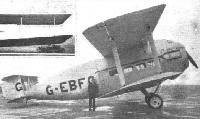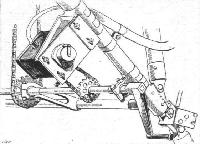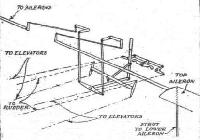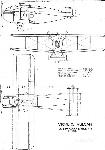
Vickers Type 61 Vulcan
В начале 1921 года началась разработка транспортного самолета Vickers Vulcan. Этот биплан с размахом крыла 14,94 м имел вместительный фюзеляж овального сечения, заполнявший по высоте все пространство между крыльями. Пилот сидел в открытой кабине перед верхним крылом, а в закрытой кабине в фюзеляже могли разместиться от шести до восьми пассажиров.
Для снижения стоимости на первых шести самолетах (Type 61) были установлены оставшиеся со времен войны 360-сильные (268 кВт) ПД Rolls-Royce Eagle VIE, но из-за невысоких летных характеристик оставшиеся две машины (Type 74) оснастили 450-сильными (336 кВт) ПД Napier Lion.
Один из ранних серийных самолетов был построен в грузовом варианте (Type 63) для испытаний Министерством авиации, но затем снова переделан в пассажирский. Вместе с еще одним самолетом с двигателями Eagle и двумя машинами с двигателями Lion, он использовался компанией «Imperial Airways» на авиалиниях в Европе. Из-за низкой надежности служба самолета Vulcan оказалась недолгой - к середине 1920-х годов на линиях оставалась одна или две уцелевшие машины.
Вариант Type 74 имел максимальную взлетную массу 3062 кг и развивал максимальную скорость 180 км/ч.
Описание:
- Vickers Type 61 Vulcan
- Flight, May 1922
THE VICKERS "VULCAN" EIGHT-PASSENGER COMMERCIAL BIPLANE
Фотографии
-
Aeroplane Monthly 1981-10 / R.Riding - The Flying Pig
Регистрационный номер: G-EBLB [8] Vickers Vulcan Type 74, G-EBLB of Imperial Airways, crashed at Purley on take off 13th July 1928.
-
Aeroplane Monthly 1987-11 / J.Stroud - Wings of Peace
The prototype Vulcan at Brooklands. It is only partially painted, has narrow-chord rudders and strut-connected ailerons.
-
Flight 1922-05 / Flight
Регистрационный номер: G-EBBL [5] THE VICKERS "VULCAN" COMMERCIAL MACHINE: Three-quarter rear view. A feature of this machine is the exceptionally low landing speed of 40 m.p.h., and the quick pull-up after touching. The "Vulcan" also gets off after a very short run, and climbs steeply. The power expenditure is only 45 h.p. per passenger carried, so that the machine should be very economical.
The first Vulcan in Instone Air Line livery as City of Antwerp. The additional fins have not yet been fitted. -
Flight 1922-05 / Flight
Регистрационный номер: G-EBBL [5] THE VICKERS "VULCAN," 360 H.P. ROLLS-ROYCE "EAGLE" ENGINE. - This machine was described and illustrated in detail in our issue of May 4, 1922, but photographs have not been available until now. The machine carries eight passengers in a roomy cabin, and will shortly be put on the London-Brussels service by the Instone Air Line.
-
Aeroplane Monthly 1981-10 / R.Riding - The Flying Pig
Регистрационный номер: G-EBBL [5] The prototype Vulcan G-EBBL was an eight-seater and seen crossing Plough Lane, Croydon, June 1922.
-
Flight 1931-10 / Flight
Регистрационный номер: G-EBEM [5] THE VICKERS "VULCAN'": One of the 1924 additions to the Imperial Airways fleet. It had a Napier "Lion" and carried seven passengers.
-
Aeroplane Monthly 1987-11 / J.Stroud - Wings of Peace
Регистрационный номер: G-EBEM [5] G-EBEM was to have been Instone's second freighter but was completed as a passenger Type 61. It is seen with additional upper and lower fins.
-
Flight 1930-01 / Flight
Регистрационный номер: G-EBEM [5] King's Cup machines. (3) Vickers "Vulcan" (450 Napier "Lion")
-
Aeroplane Monthly 1987-11 / J.Stroud - Wings of Peace
Регистрационный номер: G-EBEM [5] SOME OF THE STARTS FOR THE KING'S CUP RACE: Capt. Cockerell off on the Vickers Vulcan;
G-EBEM, probably on the occasion of the 1922 King's Cup race. -
Aeroplane Monthly 1981-10 / R.Riding - The Flying Pig
Регистрационный номер: G-EBEM [5] Vickers Vulcan G-EBEM, owned by Imperial Airways. It took part in the 1922 King’s Cup air race. Flown by Cockerell, it took seventh place, carrying seven passengers!
The picture was taken at Croydon in September 1922, where Vulcan G-EBEM is seen competing in the first King's Cup Air Race.
Although ordered by Instone for intended freight flying, this Vickers Vulcan was not purchased. -
Aeroplane Monthly 1987-11 / J.Stroud - Wings of Peace
Регистрационный номер: G-EBLB [8] The first Vulcan, seen at Croydon (Plough Lane site), in Imperial Airways service as a freighter.
-
Aeroplane Monthly 1981-10 / R.Riding - The Flying Pig
Регистрационный номер: G-EBLB [8] Vulcan G-EBLB in the original Imperial Airways dark blue and silver livery at Croydon.
-
Aeroplane Monthly 1988-02 / Personal album. Civil
Регистрационный номер: G-EBLB [8] Vickers Vulcan G-EBLB in Imperial Airways livery. Registered in May 1925, 'LB was lost in a take-off crash from Croydon on July 13, 1928.
-
Aeroplane Monthly 1987-11 / J.Stroud - Wings of Peace
Регистрационный номер: G-EBLB [8] G-EBLB at Croydon in 1928. The pilot is Gordon Olley.
-
Aeroplane Monthly 1987-11 / J.Stroud - Wings of Peace
Регистрационный номер: G-EBLB [8] G-EBLB at Zurich, apparently after a repaint or a good wash.
-
Aeroplane Monthly 1981-10 / R.Riding - The Flying Pig
Регистрационный номер: G-EBLB [8] Same aircraft, Lion engined, in the line's later all silver paint scheme.
-
Flight 1923-11 / Flight
Регистрационный номер: G-EBFC [5] ONE OF TWO "REVIEW" VICKERS MACHINES: The Vickers "Vulcan" commercial aeroplane, with one Napier "Lion" engine.
-
Aeroplane Monthly 1987-11 / J.Stroud - Wings of Peace
Регистрационный номер: G-EBFC [5] A pre-delivery view of Type 74 Vulcan G-EBFC, the first Lion-powered example. It flew for the first time on March 3, 1923 and took part in that years King's Cup air race. After service with Imperial Airways it was finally burned in 1927.
-
Aeroplane Monthly 1977-12 / Personal album
Регистрационный номер: G-EBFC [5] This photograph almost certainly depicts the first Napier Lion-powered Vickers 74 Vulcan, G-EBFC. This aircraft was delivered to Imperial Airways on December 23, 1924, although it was first flown on March 3 the previous year. 'FC was flown on continental services until December 1925 and was dismantled and burnt in 1927.
-
Flight 1924-05 / Flight
Регистрационный номер: G-EBFC [5] The Vickers "Vulcan," in its latest form, is an eight-seater passenger machine, with Napier "Lion" engine.
-
Мировая Авиация 248
Регистрационный номер: G-EBFC [5] Самолет G-EBFC - Vickers Type 74 Vulcan, заказанный авиакомпанией "Imperial Airways".
-
Flight 1924-08 / Flight
THE KING'S CUP: Three interesting machines at Hendon for the start. Left to right, Mr. Alan S. Butler's D.H.37 (275 Rolls-Royce "Falcon 3"), flown by Major H. Hemming; Mr. F. P. Raynham's Martinsyde F.6 (700 Wolseley "Viper"), piloted by himself; Mr. Douglas Vicker's Vickers "Vulcan" (450 Napier "Lion"), flown by Capt. S. Cockerell.
Другие самолёты на фотографии: De Havilland D.H.37 - Великобритания - 1922Martinsyde F.4A / F.6 / A - Великобритания - 1919
-
Aeroplane Monthly 1987-11 / J.Stroud - Wings of Peace
Регистрационный номер: G-EBLB [8] G-EBLB, still in Imperial Airways blue livery, after a mishap. It has a metal propeller.
-
Aeroplane Monthly 1981-10 / R.Riding - The Flying Pig
Регистрационный номер: G-EBBL [5] The wreckage of the prototype Vulcan near Tonbridge on June 23, 1922, three weeks after entering service.
-
Aeroplane Monthly 1987-11 / J.Stroud - Wings of Peace
Регистрационный номер: G-EBBL [5] KEITH WOODCOCK'S painting shows the Type 61 Vulcan G-EBBL City of Antwerp in Instone Air Line's livery.
-
Flight 1922-05 / Flight
The Vickers "Vulcan": Three-quarter front view of fuselage before engine cowl and fabric covering of rear portion are put on.
-
Flight 1922-05 / Flight
THE VICKERS "VULCAN": Some details of the construction of circular and streamline section struts and longerons.
-
Flight 1922-05 / Flight
THE VICKERS "VULCAN": Details of the starting gear, showing starting magneto, adjustable eccentric bushes, etc.
-
Flight 1922-05 / Flight
THE VICKERS "VULCAN": Perspective diagram of the control system.
-
Flight 1922-05 / Flight
THE VICKERS "VULCAN": Some constructional details. 1. Lattice rib construction. 2. Balanced aileron. 3. Details of aileron mounting. 4. The fairing behind the pilot's head has a tubular stiffening piece to act as a protection in case the machine turns over. Inside the fairing may be seen the ventilator for the cabin. 5. shows details of the manner of building a light structure on to the main fuselage girder in order to turn it into an elliptical section. 6. One of the fuselage longeron clips. (Note the aluminium packing piece which allows of tightening up the fitting in case of shrinkage of the longeron.) 7. One of the petrol tanks mounted on the top plane. 8 is an underneath view of the sump of the petrol tank. 9 shows the detachable steel shoe on the tail skid. 10 and 11 are views of one of the seats, open and folded. 12. Shows the details of the undercarriage where the struts meet the axle. Note how the bending moment has been kept as small as possible by fitting the struts close to the inner end of the wheel hub.
-
Aeroplane Monthly 1981-10 / R.Riding - The Flying Pig
Vickers Vulcan Type 61, G-EBDH of Instone Airline Lts.
-
Flight 1922-05 / Flight
Vickers Vulcan 375 hp Rolls Eagle VIII Engine
- Фотографии































